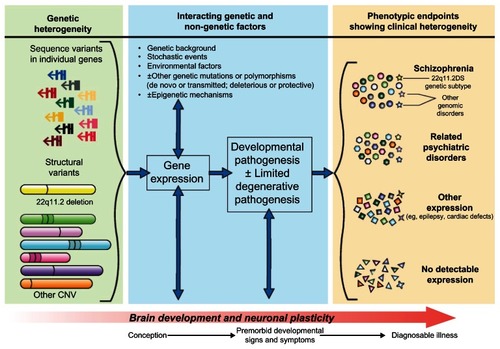Figures & data
Table 1 Schizophrenia within the context of other common complex neuropsychiatric diseases (as of 2011)
Table 2 Potential future roles for molecular genetics in the clinical management of schizophrenia
Table 3 The current established and emerging genetic subtypes of schizophrenia are characterized by large, rare, recurring copy number variation and variable expressivity
Table 4 Pathway to clinical utility for copy number variation and genomic disorders associated with schizophrenia (as of 2011)
Figure 1 Neurodevelopmental model of schizophrenia, informed by new molecular genetic discoveries. One or more transmitted or de novo sequence or structural mutations, involving one or more genes, and acting individually or interactively, is proposed as the initial causal event. The pathway from genotype to phenotype is formulated as a dynamic process beginning at or before conception, and involving gene expression (including, but not limited to, protein activity) and interaction with normal brain development and neuronal plasticity mechanisms, and likely multiple other genetic and non-genetic factors. Different phenotypic endpoints are possible, and specific factors that dictate variable expression of ostensibly the same genetic loading are largely unknown and may be variant-specific. These resulting phenotypes could include clinically diagnosable schizophrenia, other psychiatric illnesses, other conditions including disorders of development, or no detectable expression. For example, a 22q11.2 deletion (yellow structural variant) may be expressed as schizophrenia and/or a related psychiatric disorder and/or another developmental disorder (yellow stars).
Abbreviation: CNV, copy number variation.
